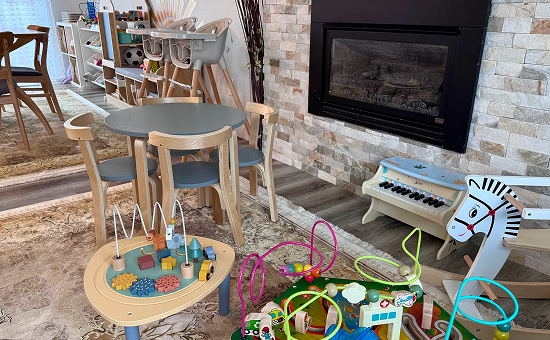Feeding toddlers can be both a rewarding and challenging experience, especially in daycare or child care settings where diverse needs must be met. By combining the nutritional guidelines of the Child and Adult Care Food Program (CACFP) with the child-centered approach of Montessori education, parents and caregivers can create a nurturing environment that promotes healthy eating habits. This guide offers practical toddler feeding tips to support healthy development without rushing the process, tailored for families and daycare providers in Bothell.
Why Toddler Feeding Matters in Daycare and Child Care
Toddlers are at a critical stage of growth, where proper nutrition supports physical, cognitive, and emotional development. In daycare and child care settings, feeding routines play a pivotal role in establishing lifelong healthy eating habits. However, toddlers are also developing independence, which can lead to picky eating or mealtime struggles. By adopting structured yet flexible approaches like those outlined in CACFP and Montessori, caregivers can make mealtimes a positive experience.
In Bothell, where families seek high-quality daycare and child care, providers must balance nutritional standards with individualized attention. This article explores how to achieve this balance, ensuring toddlers thrive in both home and daycare environments.
Understanding CACFP Guidelines for Toddler Nutrition
The Child and Adult Care Food Program (CACFP) provides evidence-based guidelines for serving nutritious meals and snacks in daycare and child care settings. These guidelines ensure toddlers receive balanced meals that meet their developmental needs.
Key CACFP Guidelines for Toddlers (Ages 1–3):
- Meal Components: Meals must include fruits, vegetables, grains, protein foods, and milk (or milk alternatives).
- Portion Sizes: Appropriate portions prevent overfeeding while meeting nutritional needs (e.g., ¼ cup of vegetables or fruit per meal for ages 1–2).
- Limit Sugars and Processed Foods: CACFP emphasizes whole foods and restricts added sugars to promote healthy growth.
- Meal Frequency: Toddlers should have two meals and one snack (or two snacks and one meal) during a daycare day, depending on hours.
By adhering to CACFP standards, daycare providers in Bothell can ensure toddlers receive balanced, age-appropriate nutrition that supports their energy and growth.

Montessori Principles for Toddler Feeding
The Montessori approach emphasizes independence, respect for the child’s pace, and hands-on learning. When applied to feeding, Montessori principles encourage toddlers to develop self-reliance and a positive relationship with food.
Core Montessori Feeding Principles:
- Child-Led Exploration: Allow toddlers to explore food textures and flavors at their own pace.
- Practical Life Skills: Involve children in simple food-related tasks, such as setting the table or serving themselves.
- Prepared Environment: Create a calm, distraction-free space for eating to foster focus and mindfulness.
- Respect for Individuality: Honor each child’s preferences and readiness without forcing or rushing.
Combining Montessori’s child-centered philosophy with CACFP’s nutritional framework creates a holistic approach to toddler feeding, ideal for daycare and child care settings.
Practical Toddler Feeding Tips
Here are actionable tips inspired by CACFP and Montessori to make mealtimes successful in daycare, child care, or at home.
Create a Calm Eating Environment
A peaceful mealtime environment helps toddlers focus on eating and reduces stress. In a daycare setting, this is especially important with multiple children.
- Minimize Distractions: Turn off screens and keep toys away from the table.
- Use Child-Sized Furniture: Montessori-style tables and chairs make toddlers feel comfortable and independent.
- Set a Routine: Consistent meal and snack times align with CACFP guidelines and help toddlers feel secure.
Encourage Self-Feeding with Montessori Tools
Montessori emphasizes independence, and self-feeding is a key skill for toddlers. Provide tools that support this development:
- Child-Sized Utensils: Small spoons and forks are easier for tiny hands to manage.
- Open Cups and Plates: Use sturdy, open cups instead of sippy cups to promote motor skills, and provide plates with sections to encourage variety.
- Model Behavior: Caregivers should demonstrate proper utensil use and table manners.
Self-feeding aligns with CACFP’s focus on fostering healthy eating habits while empowering toddlers.
Follow CACFP Portion Sizes
Overfeeding or underfeeding can disrupt a toddler’s appetite and growth. CACFP provides clear portion size guidelines:
- Fruits and Vegetables: ¼ cup per meal for ages 1–2, increasing to ½ cup for ages 3–5.
- Grains: ½ slice of bread or ¼ cup of cooked grains per meal.
- Protein: 1 ounce of meat, fish, or cheese, or ¼ cup of beans.
- Milk: ½ cup for ages 1–2, served at least twice daily.
In Bothell daycare settings, adhering to these portions ensures nutritional balance without overwhelming young eaters.
Introduce Variety Gradually
Toddlers can be hesitant about new foods. Introduce variety slowly to build acceptance:
- Offer One New Food at a Time: Pair it with familiar foods to reduce resistance.
- Use Colorful Presentations: Bright fruits and vegetables attract toddlers’ attention.
- Be Patient: Montessori principles encourage repeated exposure without pressure—toddlers may need 10–15 tries to accept a new food.
This approach supports CACFP’s emphasis on diverse, whole foods while respecting the child’s pace.
Involve Toddlers in Food Preparation
Montessori encourages practical life activities, such as helping with food prep, to build confidence and interest in eating.
- Simple Tasks: Let toddlers wash vegetables, pour ingredients, or spread butter with a child-safe knife.
- Safe Tools: Provide Montessori-approved tools like small cutting boards or blunt knives.
- Supervised Participation: In daycare settings, caregivers can guide group activities like making fruit salads.
Involving toddlers fosters a sense of ownership over their meals, making them more likely to try new foods.
Common Challenges and Solutions
Challenge: Picky eating in daycare settings.
Solution: Offer a variety of CACFP-approved foods and allow toddlers to choose what to eat from their plate. Avoid forcing food, as Montessori principles prioritize autonomy.
Challenge: Messy self-feeding.
Solution: Embrace messes as part of learning. Use easy-to-clean surfaces and provide bibs or smocks. Celebrate small successes to build confidence.
Challenge: Time constraints in busy daycare schedules.
Solution: Streamline meal prep with CACFP-compliant menus planned in advance. Use Montessori-style routines to make mealtimes efficient yet calm.
Challenge: Allergies or dietary restrictions.
Solution: Work with parents to create individualized plans, ensuring CACFP guidelines are met with safe alternatives.
About KidoHeaven: Your Trusted Child Care Partner in Bothell
KidoHeaven is dedicated to providing nurturing, high-quality daycare and child care services in Bothell. Our approach combines CACFP nutritional standards with Montessori principles to foster healthy development in toddlers. From balanced meals to child-led activities, we create an environment where children thrive. Whether you’re seeking daycare in Bothell or child care in Bothell, KidoHeaven is here to support your family’s needs. Contact us today to learn how we can help your toddler grow and flourish.
Why KidoHeaven Stands Out
✅ Licensed in Washington State
✅ Aligned with Early Achievers standards
✅ Working Connections subsidy accepted
✅ Daily updates via Brightwheel
✅ Located in Bothell, serving Mill Creek, Lynnwood & nearby areas
✅ Nutritious snacks, safe outdoor space, & positive mealtime routines
📞 Call 206-734-2040 to schedule a tour
🌐 Enroll now
Follow Our Mealtime Moments
Stay updated with more beautiful outdoor meals and daily learning routines on:
Instagram | Facebook | Nextdoor | Yelp | Winnie | YouTube | Upwards
FAQ
1. How can I make mealtimes less stressful for toddlers in daycare?
Create a calm environment with child-sized furniture, consistent routines, and minimal distractions, as recommended by Montessori principles.
2. What foods should I serve to meet CACFP guidelines?
Include fruits, vegetables, whole grains, proteins, and milk in age-appropriate portions, avoiding processed foods and added sugars.
3. How do I encourage a picky toddler to eat?
Offer new foods gradually, involve them in prep, and model positive eating behaviors without pressure, per Montessori methods.
4. Can Montessori feeding practices work in a busy daycare?
Yes, by using child-sized tools, structured routines, and group activities, daycare providers can implement Montessori principles efficiently.



